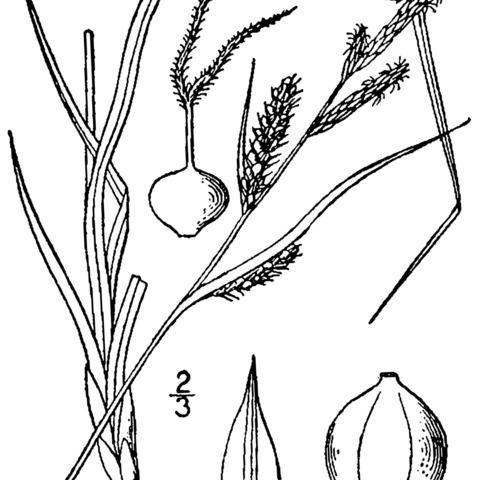Plants tufted, the slender stems arising laterally, scabrous on the angles, 5–12 dm, usually much overtopping the lvs; lowest lvs reduced to dark reddish-brown, bladeless sheaths; main lvs 2–5 mm wide, inversely W-shaped in x-section, the sheaths glabrous, dorsally green, with a concave, red-dotted mouth; lowest bract lf-like, usually a little shorter than the infl, the others much reduced; staminate spikes 1–3, the terminal one 2–5 cm, the others much smaller; pistillate spikes 2 or 3, sessile or nearly so, erect, separate or somewhat overlapping, 1–5 cm, linear-cylindric, the uppermost with some distal staminate fls; pistillate scales with green midvein and dark brown sides, narrower than the perigynia, long-acuminate and projecting 0.5–1.5 mm beyond them; perigynia 1.5–2.6 mm, olive-green with red dots, biconvex, rounded-obovoid and slightly inflated, rounded above to a minute beak, with 1 or 2 faint nerves on each side; achene lenticular, loosely enveloped in the lower half of the perigynium; 2n=54. Marshes, wet meadows, and wet, open woods; N.B. to Minn. and S.D., s. to N.J., Pa., Ind., and Mo.
More
Plants cespitose. Culms acutely angled, 30–115 cm, scabrous. Leaves: basal sheaths red-brown, indistinctly ladder-fibrillose; sheaths of proximal leaves glabrous, fronts with red-brown spots, veinless, apex U-shaped; blades 3–5 mm wide. Inflorescences: proximal bract subequal to inflorescence, 2–4 mm wide. Spikes erect; proximal 2–3 spikes pistillate, 1–5 cm × 4–6 mm, base obtuse; terminal 1–2 spikes staminate. Pistillate scales red-brown, longer than perigynia, apex acute or acuminate, awnless. Perigynia divergent, olive-brown with red-brown spots on apical 1/2, veinless, inflated, loosely enclosing achenes, obovoid, 1.5–2.8 × 1.5–2 mm, dull, apex rounded, papillose; beak green, 0.1–0.2 mm. Achenes not constricted, glaucous. 2n = 54.


